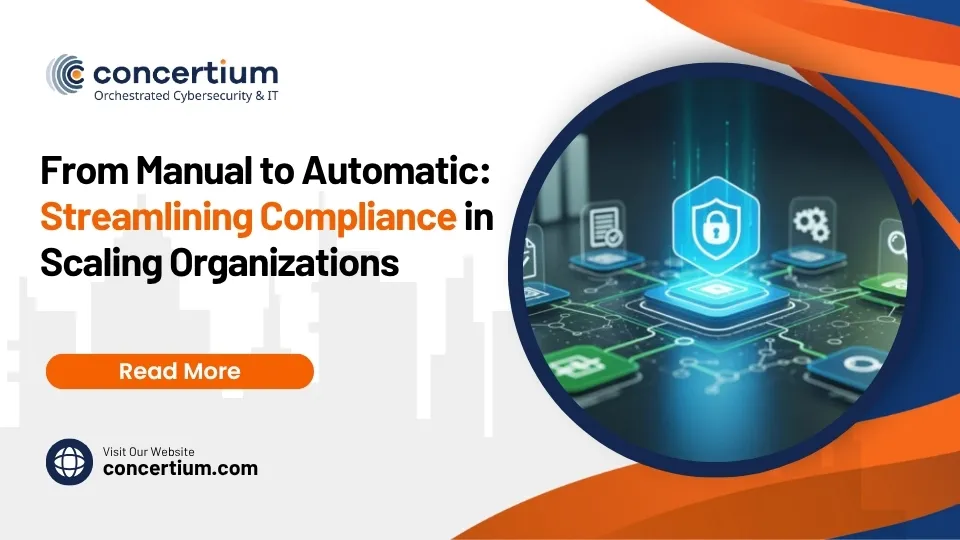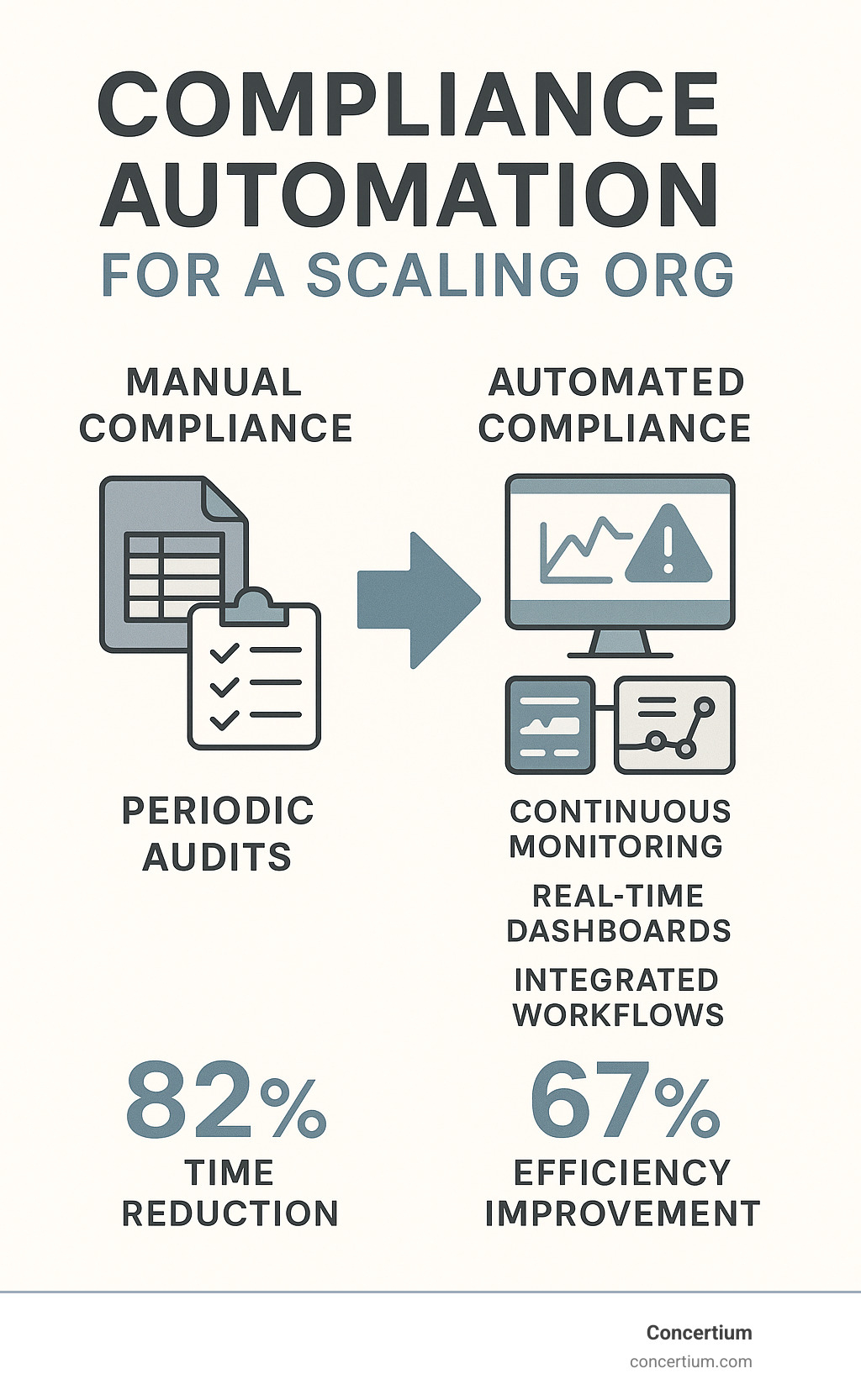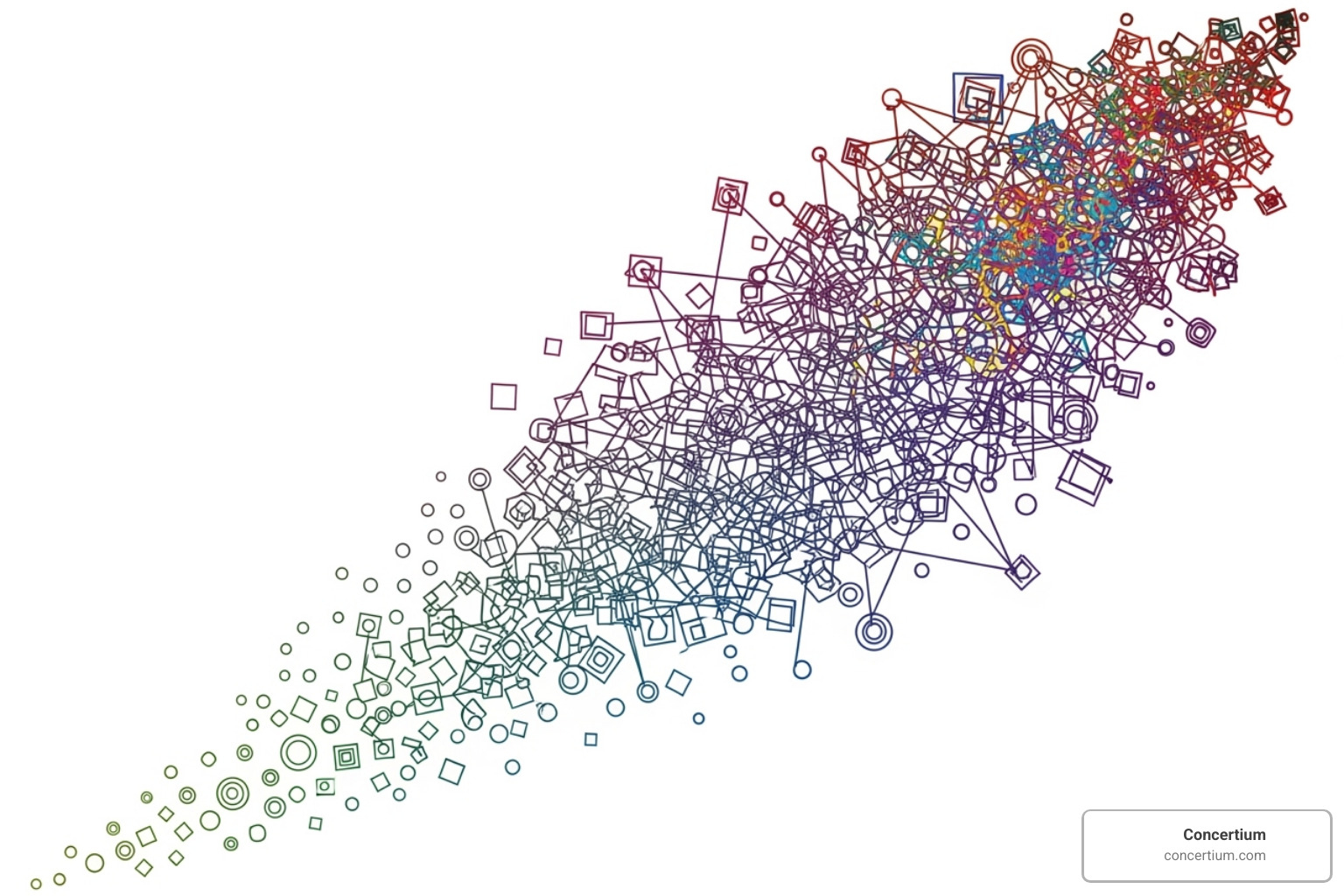Compliance automation software for a scaling org transforms manual, time-consuming processes into streamlined workflows that grow with your business. Here’s what scaling organizations need to know:
Essential Features:
- Automated evidence collection across multiple systems
- Real-time control monitoring and alerts
- Framework cross-mapping (SOC 2, ISO 27001, HIPAA)
- Centralized policy and documentation management
- Integration with existing security tools
When to Transition:
- Team size exceeds 50 employees
- Managing 2+ compliance frameworks
- Pursuing enterprise customers
- Preparing for Series B funding or beyond
Key Benefits:
- 82% reduction in time per framework
- 340% faster evidence collection vs. manual methods
- 67% reduction in compliance effort for mid-growth companies
As companies grow, their once-manageable compliance programs often become bottlenecks. This scenario plays out across thousands of scaling organizations. According to recent industry data, respondents spend an average of nine working weeks per year on security compliance. While only 37% of early-stage startups cite compliance as a significant challenge, this jumps to 78% for scale-ups with more than 50 employees.
The math is simple but painful. The average Series B company manages 3.7 compliance frameworks compared to just 1.2 for seed-stage startups. Companies using manual methods experience a 340% increase in evidence collection time when scaling from early-stage to growth-stage operations.
This creates what researchers call the “compliance complexity inflection point”—typically hitting around 80-100 employees when manual oversight becomes ineffective for ensuring consistent security practices.
Know your compliance automation software for a scaling org terms:
The Breaking Point: Why Manual Compliance Fails Scaling Businesses
For many scaling businesses, there’s a painful moment when manual compliance processes transform from manageable quirks into business-threatening bottlenecks. This is the compliance complexity inflection point.
As headcount and the number of compliance frameworks grow, so does organizational complexity. More employees, departments, and tools mean more data sources to monitor. What was once a simple process becomes a coordination nightmare.
Evidence collection time can increase dramatically, draining resources that should be focused on growth. This leads to compliance fatigue, as teams get bogged down in repetitive, manual tasks. Manual processes also create siloed data scattered across spreadsheets and emails, making it impossible to get a real-time view of your compliance posture or reuse work across different frameworks.
This is where effective Governance, Risk, and Compliance (GRC) Strategies become essential, as traditional methods fail. Compliance automation software for a scaling org addresses these breaking points by changing scattered, manual processes into streamlined workflows that grow with your business instead of holding it back.
The pain of staying manual quickly outweighs the effort of making the transition. Smart scaling organizations recognize this inflection point and act before compliance becomes a competitive disadvantage.
The Shift to Automation: Key Benefits and When to Make the Move
Watching your team drown in spreadsheets isn’t just painful—it’s expensive. The shift to automated, proactive compliance isn’t just about making life easier. It’s about changing compliance from a business bottleneck into a competitive advantage.
Compliance automation software for a scaling org changes the equation by delivering tangible business benefits:
- Increased Efficiency and Reduced Costs: Automation handles continuous evidence collection, freeing up your team for strategic work. Organizations see compliance effort drop by up to 67% for mid-growth companies, with some reducing compliance costs from 35-40% of security budgets down to just 15-20%. Audit time can be cut in half, with some reporting an 82% reduction in time spent per framework.
- Business Acceleration: Streamlined compliance speeds up business. Sales cycles shorten because you can respond to security questionnaires in days, not weeks, with an average reduction of 37 days. Market entry happens faster—an average of 45 days sooner—because you aren’t scrambling to meet new regulations.
- Stronger Security and Trust: Continuous monitoring catches issues faster than periodic check-ins, strengthening your overall security posture. This evidence-based approach to Compliance and Risk Management builds deeper, more durable relationships with customers.
This is why investing in Cybersecurity Compliance Services: Top 3 Benefits has moved from “nice to have” to “essential for survival” for growing companies.
When to Transition to Automation
The question isn’t whether you should automate—it’s when. If three or more of these situations apply to you, automation isn’t just beneficial—it’s urgent.
- Team size is over 50: You’ve likely hit the complexity wall where manual oversight becomes ineffective.
- Managing multiple frameworks: Juggling SOC 2, ISO 27001, and HIPAA manually is time-consuming and error-prone.
- Pursuing enterprise customers: These clients demand comprehensive, detailed proof of security that is difficult to compile manually.
- Preparing for Series B funding: Investors scrutinize operational maturity. An automated compliance program signals you’re ready to scale responsibly.
- Operating in multiple jurisdictions: GDPR in Europe, different state regulations in the US—manual tracking becomes a nightmare. For these organizations, Compliance Management for PE/VC Firms becomes critical.
Choosing the Right Compliance Automation Software for a Scaling Org
Finding the perfect compliance automation software for a scaling org is a critical decision. It’s tempting to build a custom solution, but the data shows this is often a mistake.
Companies that build custom compliance tools spend 3.4 times more on initial development and 5.7 times more on ongoing maintenance. With 68% of custom projects failing to deliver on time, your engineering team’s talent is better spent on your core product. The smarter move is investing in a future-proof platform. We help clients steer these decisions with our GRC Automation Tools expertise, ensuring they pick solutions that truly scale.
Essential Features for Scalability
When evaluating software, these features are the foundation of a system that will serve you as you grow.
- Continuous controls monitoring: Get 24/7 oversight of your systems, automatically gathering evidence and monitoring adherence to frameworks.
- Automated evidence collection: Eliminate manual screenshots by connecting seamlessly with your cloud providers, HR systems, and other tools to pull evidence automatically.
- Framework cross-mapping: Assess once and comply many times. The software should map overlapping controls (SOC 2, ISO 27001, HIPAA, etc.) so you don’t duplicate work.
- Centralized control library: A single source of truth for all policies, procedures, and documentation.
- Risk management integration: Connect risks directly to your compliance controls for a holistic view of your security posture.
- Real-time reporting dashboards: Customizable dashboards show you what’s working and what needs attention, providing crucial visibility.
- API and tool integrations: Deep connections with your security, IT, and business tools create automated workflows and reduce manual handoffs.
Aligning Software with Your Growth Stage
Your compliance needs evolve as you scale. Your software should evolve with you.
- Early-growth (25-75 employees): Focus on fundamentals like centralized policy management and a reliable evidence repository to ditch spreadsheets.
- Mid-growth (75-200 employees): Automated evidence collection and continuous monitoring become non-negotiable to keep pace with complexity. Expect 60-75% efficiency improvements.
- Scale-up (200+ employees): Demand enterprise-grade capabilities like advanced cross-framework mapping and robust API integrations. Mature implementations can reduce compliance costs to just 15-20% of security budgets.
Our Automated Compliance Monitoring approach ensures your solution grows intelligently with your organization.
Evaluating Your Options for compliance automation software for a scaling org
Approach vendor evaluation like you’re hiring a key team member.
- Framework support: Does the platform handle your current and future frameworks (SOC 2, ISO 27001, HIPAA, GDPR, PCI DSS)?
- Ease of use: An intuitive platform is crucial for team adoption.
- Customer support and training: Strong support is invaluable during setup and ongoing operations.
- No-code customization: The ability to configure custom controls and risk matrices without code provides essential flexibility.
- Integration ecosystem: Seamless connections with your existing tech stack automate data flow and eliminate manual work.
- AI capabilities: Look for features like automated risk flagging and AI-generated responses to boost efficiency.
Selecting the right partner for Compliance Risk Advisory Services is as important as choosing the software itself.
A Practical Guide to Implementing and Measuring Success
Adopting compliance automation software for a scaling org isn’t like flipping a switch. It requires careful planning and a phased approach to thrive. Organizations that use a phased rollout see a positive ROI 2.7 times quicker and gain 3.2 times greater efficiency by tackling the biggest headaches first.
Your compliance efforts shouldn’t live in a silo. By embedding security checks into development (“Security as Code”) and automatically verifying compliance (“Compliance as Code”), compliance becomes a powerful tool for managing risk. This is fundamental to Mastering Risk Management Compliance Strategies.
Best Practices for a Smooth Implementation
To ensure your journey to automated compliance is smooth, follow these best practices:
- Start with high-impact areas: Automate the most time-consuming manual tasks first, like evidence gathering, to show immediate value.
- Consolidate frameworks: Create a master list of controls that covers all your requirements to reduce duplicate work.
- Automate evidence collection first: This is often the biggest time drain, so automating it provides a huge win right away.
- Train the team: Ensure everyone from compliance to IT and security knows how to use the new software effectively.
- Establish clear ownership: Define who manages the software, interprets data, and acts on alerts to prevent confusion.
- Document everything: Keep clear records of your automated processes for auditors and continuous improvement, which is vital for regulations like GDPR Compliance in Cybersecurity.
Measuring ROI and the Success of your compliance automation software for a scaling org
How do you know if your investment is paying off? Success should be measured with clear, tangible metrics. Here’s how automation transforms key compliance areas, moving you from manual headaches to streamlined success:
| Metric | Manual Approach | Automated Approach | Improvement |
|---|---|---|---|
| Time on Security Compliance | ~9 working weeks per year per person | Significantly reduced | 82% less time per framework |
| Evidence Collection Time | 340% increase when scaling | Reduced from weeks to days (e.g., 6 weeks to 3 days) | Substantial reduction (e.g., 340% faster) |
| Compliance Maintenance Effort | High, repetitive | Reduced by 45% (early-growth), 67% (mid-growth) | Significant reduction |
| Audit Preparation Time | Weeks to months | Cut in half or more | Drastic reduction |
| Security Questionnaire Response Time | ~2 weeks | ~2 days | 90% faster |
| Enterprise Sales Cycles | Often delayed by compliance | Decreased by 37 days on average | Accelerated |
| Compliance Team Productivity | Strained, prone to fatigue | Boosted by 129% | More efficient, strategic team |
| New Market Entry | Slowed by regulatory problems | Accelerated by 45 days on average | Faster business expansion |
| Overall ROI | Negative, cost center | 526% ROI over three years, pays for itself in 3 months | Positive, growth enabler |
These numbers represent the real-world impact of automation. A phased implementation helps organizations achieve these returns faster, showing how smart, step-by-step changes lead to significant results.
Frequently Asked Questions about Compliance Automation
It’s normal to have questions when considering automating your compliance processes. Here are some of the most common ones we hear from scaling organizations.
How much time does compliance automation really save?
The time savings are transformative. Manually, teams can spend about nine working weeks per year on security compliance. With automation, you can spend 82% less time on each framework and make evidence collection 340% faster. Instead of weeks of compiling data for an audit, an automated system can gather that evidence in days. Continuous monitoring gives your team real-time visibility, allowing them to proactively address issues and save countless hours of reactive work.
Can one tool manage multiple frameworks like SOC 2, ISO 27001, and GDPR?
Yes, and this is a major benefit. Modern compliance automation software for a scaling org offers “framework cross-walking.” This means you can map a single control—like annual security awareness training—to every framework that requires it (SOC 2, ISO 27001, GDPR, etc.). You collect the evidence once, and the software applies it across all relevant frameworks. This eliminates duplicate work and ensures consistency. Our approach to GDPR Compliance in Cybersecurity Services is built on this efficiency.
How does automation improve overall security posture?
Automation is a strategic asset that builds a stronger, more resilient security posture.
- Real-time Visibility: Continuous monitoring provides an immediate, up-to-the-minute view of your security posture, unlike outdated periodic snapshots.
- Proactive Alerts: The software sends immediate alerts if a control fails, empowering your team to fix vulnerabilities before they become major incidents.
- Faster Remediation: Clear alerts and AI-generated suggestions help your team resolve issues much faster, minimizing the window of vulnerability.
- Integrating Security and Compliance: Automation helps bridge the gap between security operations and compliance by embedding checks directly into your workflows.
- Evidence-Based Trust: A constant stream of high-quality evidence satisfies auditors and builds a culture of continuous assurance, fostering unwavering trust with clients.
Conclusion
The shift from manual to automated compliance is a fundamental change in how your organization operates and grows. By implementing compliance automation software for a scaling org, you choose efficiency over chaos and growth over stagnation.
The numbers are compelling: 82% less time per framework, 67% reduction in compliance effort, and a 526% ROI over three years. But the real impact is freeing your talented team from manual tasks to focus on strengthening security, enabling growth, and building customer trust.
The strategic advantage is clear. Companies that accept automation enter new markets 45 days faster and close enterprise deals 37 days sooner, building evidence-based trust that becomes a competitive differentiator.
At Concertium, we’ve spent nearly 30 years helping organizations steer cybersecurity and compliance. Our Collective Coverage Suite (3CS) with AI-improved observability and automated threat eradication changes compliance from a necessary evil into a business accelerator.
The question isn’t if you’ll automate, but when. Your stakeholders—investors, customers, and employees—are counting on you to build a secure, compliant, and scalable organization. The right automation platform makes this inevitable.
Transform your compliance program with the right compliance automation software.






